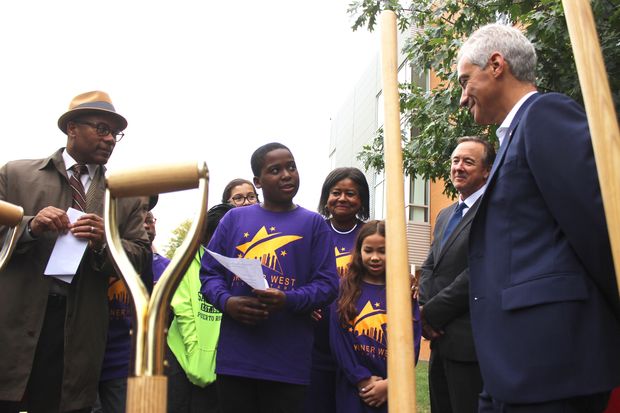
WEST LOOP — With students squeezed into "every nook and cranny" of Skinner West Elementary School, Principal Deborah Clark had one thing on her mind any time she saw Mayor Rahm Emanuel.
"I couldn't even say, 'Good morning, how are you?' before I would say, 'We need more space,'" Clark said. "I'd beg, I'd plead, I'd beat him up."
But with the city breaking ground on a $20 million, four-story expansion Thursday, Clark has gotten her wish: Room for hundreds more students at an overcrowded, top-rated elementary school.
But to the mayor, Clark's persistence was precisely what made Skinner such a success.
"What happens here is special. It's not [what happens] everywhere," Emanuel said, echoing a student's reflections on Skinner West. "The three key things for any child is involved parents, teachers that motivate and a principal that's not scared to be held accountable.
"You put those three together, and I don't care where a child comes from," the mayor said, "they're going to succeed."
The four-story addition will bring 22 new classrooms, an art room, computer room, science lab and multi-purpose room that can accommodate 120 students for lunch. Currently, the school has 38 classrooms, five of which are on the satellite campus at Jackson Boulevard and Aberdeen Street.
 The city began work Thursday on a 36,000-square-foot expansion at Skinner West Elementary School. [Provided/City of Chicago]
The city began work Thursday on a 36,000-square-foot expansion at Skinner West Elementary School. [Provided/City of Chicago]
Expected to open in early 2019, the expansion was highly sought after for the top-ranked school that is bursting at the seams just eight years after it was rebuilt.
Part selective enrollment, part neighborhood school, Skinner West, 1260 W. Adams St., operates at 120 percent capacity, according to a 2016 Chicago Public Schools report.
Class sizes have swelled to 40 students in some cases, according to Skinner's Local School Council. This year, enrollment further increased by 24 students for a total 1,073.
The school's ideal capacity is 870 students, and CPS CEO Forrest Claypool said the 36,000-square-foot expansion will boost that by about 500 students, making room for about 1,370 students at Skinner West.
Since the school was rebuilt in 2009 with TIF money, Skinner's addition of a neighborhood component has led to a skyrocketing leap in student enrollment and parents who flock to the West Loop and the Near West Side for a better shot at an elementary school ranked as the best in Chicago.

Students and city officials, including Mayor Rahm Emanuel, break ground on a four-story expansion at Skinner West Thursday, Oct. 12, 2017. [DNAinfo/Ariel Cheung]
In 2009, attendance was 618 students, according to CPS records. Five years later, an additional 285 students were enrolled. In the past decade, the enrollment has grown by 73 percent.
The need for more seats at the school comes as the demand for homes and number of new housing units in the West Loop has skyrocketed — a frenzy that has been fueled in part by the guarantee that students in the neighborhood get admission to the prestigous school.
"Every developer that builds here uses Skinner as part of their selling points," Ald. Walter Burnett Jr. (27th) said. "So many people are moving to this neighborhood just because they want their children to go to this school."
And in turn, Burnett said, that's good for both the West Loop and Skinner West.
"It brings the community in, and they really support this school," he said during Thursday's ground breaking. "That's why we need to have more of these selective enrollment schools to have a community component."
In recent years, Skinner's LSC made a number of cuts in an effort to address overcrowding. At the direction of CPS, the school cut a program that allowed classical students' siblings automatic enrollment at the school. Then the number of classical classes was cut, making way for more neighborhood classes.
Skinner West leaders also moved classes into science labs and cut a tuition-based preschool program for 3-year-olds and a preschool program for children with autism to allow more space.
News of the expansion was announced in a closed-door meeting in July 2016, which key city officials banned reporters from attending. At the time, the proposal called for 15 new classrooms.
Preliminary renderings were released in a similar manner in November.



















